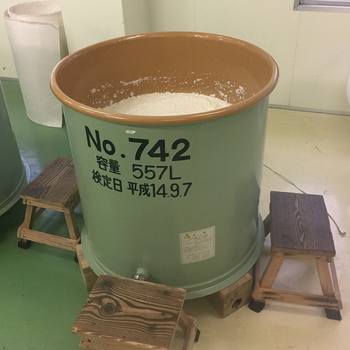
A fermentation starter tank.
There are several methods for making the fermentation starter. To learn specifics about fermentation starter production and ingredients, you can learn more by exploring the fermentation starter production method links below:
• Sokujo: The so-called “modern” or “fast” shubo method where lactic acid is added manually at the beginning of making the fermentation starter.
• Yamahai: Created in 1909, this is an update/alternative to the kimoto method that still allows for the natural build up of lactic acid but and does not require mashing the rice with long poles.
• Kimoto: The original old school shubo production method that allows for the natural build up of lactic acid and requires mashing the rice with long poles to encourage scarification.
• Bodai-moto: An ancient version of fermentation starter production that could be considered a pre-cursor to the kimoto method.
See Also:
Shubo
Moto
Yeast Starter
Kimoto
Yamahai
Sokujo
Bodai-moto


